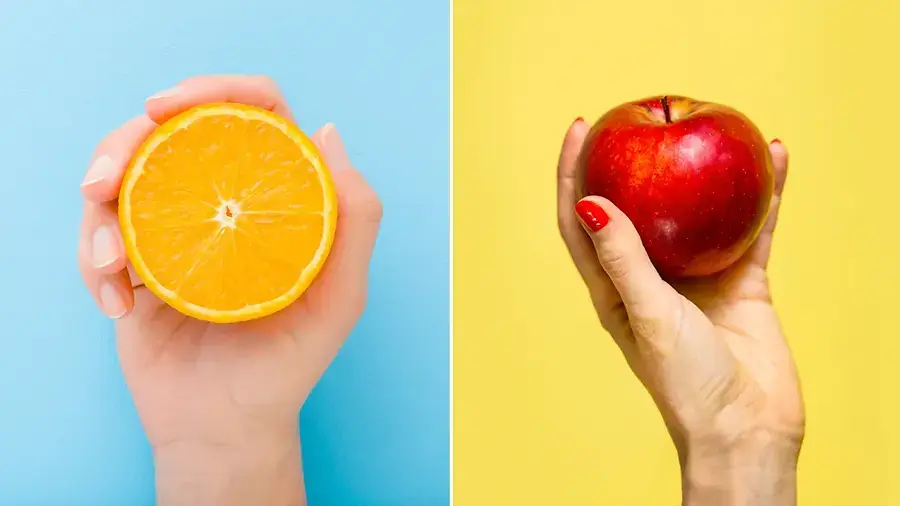Apples vs. Oranges: The Age-Old Question
Exploring the Nutritional Similarities and Differences Between Two of Nature's Most Popular Fruits

“Apples and oranges.” It’s a common phrase used when comparing two things that seem different but are actually quite similar. This leaves us with several questions the first time we hear it: What are the similarities between apples and oranges? What makes them so different? Why am I suddenly craving both? And, of course, the age-old question: Which is better?
Fear not, friend! As we explore the appearance, growing conditions, classifications, and nutritional value of apples and oranges, all the answers will be revealed. May the most nutritious snack win!
Appearance, Classifications, and Growing Conditions
Let’s begin our analysis by examining the appearance and classifications of apples—along with the growing conditions associated with both fruits. Apples grow in a variety of colors, including red, yellow, green, pink, and even multicolored varieties (Mazmanyan & Baghinyan, 2023). They also fall into different classifications, such as dessert apples, cooking apples, and cider apples (Mazmanyan & Baghinyan, 2023).
Interestingly, their growing conditions are quite similar to orange trees. Both prefer full sun but can tolerate partial shade (Mazmanyan & Baghinyan, 2023). These shared growing preferences may help explain some of the similarities in their macronutrient composition.
Macronutrients and Composition
Oranges and apples have nearly identical water content—only a little over a 1% difference (86.8% in oranges vs. 85.6% in apples) (Mazmanyan & Baghinyan, 2023). Although apples contain slightly more calories—52 per 100g compared to 47 calories in the same serving size of oranges—they are both considered low-calorie snacks.
Neither apples nor oranges contains more than a gram of protein, but differences begin to appear in their fat composition. Both fruits are very low in fat, but apples contain slightly higher levels due to their greater amount of polyunsaturated fatty acids (Mazmanyan & Baghinyan, 2023).
When it comes to macronutrients, oranges contain more saturated and monounsaturated fats. As you may be noticing, for every similarity, there is a difference. Despite sharing similar growing conditions, apples and oranges hold their nutritional individuality almost like teenagers determined to be different—imagine Arnold Schwarzenegger and Danny DeVito in the 1988 comedy Twins. The comparison is nearly as comical as the simplicity of the phrase “apples and oranges.”
Nutritional Differences: The Vitamin C Showdown
Much like Twins, the differences continue. One of the most notable distinctions is the significantly higher concentration of vitamin C found in oranges. This is especially important when considering daily vitamin requirements. Consuming one orange nearly fulfills the recommended daily intake of vitamin C, offering 69.7 mg per fruit (131 g) compared to the recommended 75–90 mg (Mazmanyan & Baghinyan, 2023).
Despite this difference, both apples and oranges share a complete absence of vitamin D and vitamin B12 (Mazmanyan & Baghinyan, 2023). Once again proving that these two fruits are truly tick for tack!
Final Thoughts: Which One Wins?
When comparing apples and oranges, it’s easy to focus on obvious differences in color and shape. However, a closer look reveals that they are more similar than they appear. Both offer a healthy, low-calorie, low-carb, and low-fat snack packed with nutrients (Mazmanyan & Baghinyan, 2023). They also both make refreshing beverages when squeezed!
But when we examine their overall nutritional value—particularly vitamins and minerals—oranges come out on top for those seeking higher levels of vitamin C, copper, calcium, and potassium (Mazmanyan & Baghinyan, 2023).
So, while apples may keep the doctor away, oranges might just keep your nutrient levels soaring.
References
FoodData Central. (2019, April 1). FoodData Central Search Results. https://fdc.nal.usda.gov/fdc-app.html#/food-details/169097/nutrients
Mazmanyan, V., & Baghinyan, A. (2023, July 4). Orange vs. Apple – Health Impact and Nutrition Comparison. Food Struct. https://foodstruct.com/compare/oranges-vs-apples


